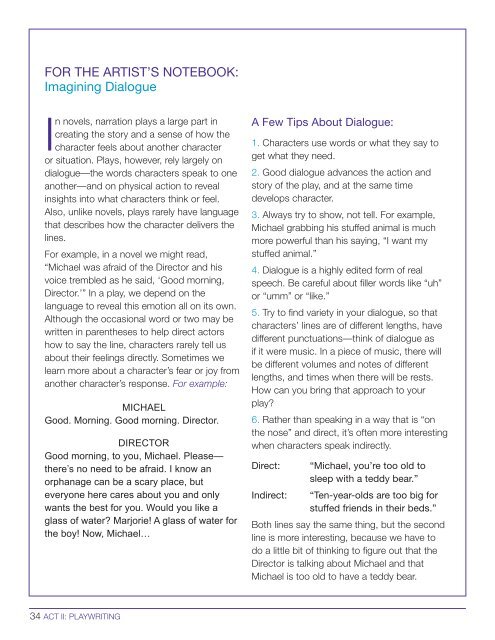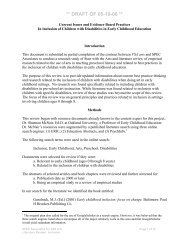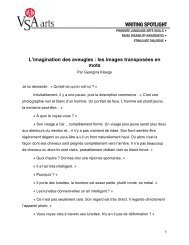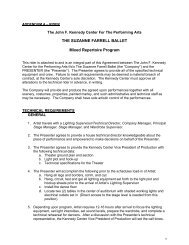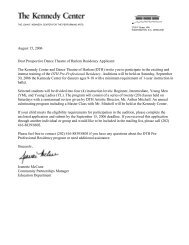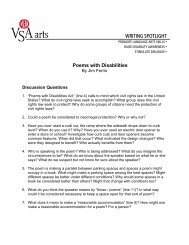Playwright Discovery Award Teacher's Guide - The John F. Kennedy ...
Playwright Discovery Award Teacher's Guide - The John F. Kennedy ...
Playwright Discovery Award Teacher's Guide - The John F. Kennedy ...
You also want an ePaper? Increase the reach of your titles
YUMPU automatically turns print PDFs into web optimized ePapers that Google loves.
FOR THE ARTIST’S NOTEBOOK:<br />
Imagining Dialogue<br />
In novels, narration plays a large part in<br />
creating the story and a sense of how the<br />
character feels about another character<br />
or situation. Plays, however, rely largely on<br />
dialogue—the words characters speak to one<br />
another—and on physical action to reveal<br />
insights into what characters think or feel.<br />
Also, unlike novels, plays rarely have language<br />
that describes how the character delivers the<br />
lines.<br />
For example, in a novel we might read,<br />
“Michael was afraid of the Director and his<br />
voice trembled as he said, ‘Good morning,<br />
Director.’” In a play, we depend on the<br />
language to reveal this emotion all on its own.<br />
Although the occasional word or two may be<br />
written in parentheses to help direct actors<br />
how to say the line, characters rarely tell us<br />
about their feelings directly. Sometimes we<br />
learn more about a character’s fear or joy from<br />
another character’s response. For example:<br />
MICHAEL<br />
Good. Morning. Good morning. Director.<br />
DIRECTOR<br />
Good morning, to you, Michael. Please—<br />
there’s no need to be afraid. I know an<br />
orphanage can be a scary place, but<br />
everyone here cares about you and only<br />
wants the best for you. Would you like a<br />
glass of water? Marjorie! A glass of water for<br />
the boy! Now, Michael…<br />
A Few Tips About Dialogue:<br />
1. Characters use words or what they say to<br />
get what they need.<br />
2. Good dialogue advances the action and<br />
story of the play, and at the same time<br />
develops character.<br />
3. Always try to show, not tell. For example,<br />
Michael grabbing his stuffed animal is much<br />
more powerful than his saying, “I want my<br />
stuffed animal.”<br />
4. Dialogue is a highly edited form of real<br />
speech. Be careful about filler words like “uh”<br />
or “umm” or “like.”<br />
5. Try to find variety in your dialogue, so that<br />
characters’ lines are of different lengths, have<br />
different punctuations—think of dialogue as<br />
if it were music. In a piece of music, there will<br />
be different volumes and notes of different<br />
lengths, and times when there will be rests.<br />
How can you bring that approach to your<br />
play?<br />
6. Rather than speaking in a way that is “on<br />
the nose” and direct, it’s often more interesting<br />
when characters speak indirectly.<br />
Direct:<br />
Indirect:<br />
“Michael, you’re too old to<br />
sleep with a teddy bear.”<br />
“Ten-year-olds are too big for<br />
stuffed friends in their beds.”<br />
Both lines say the same thing, but the second<br />
line is more interesting, because we have to<br />
do a little bit of thinking to figure out that the<br />
Director is talking about Michael and that<br />
Michael is too old to have a teddy bear.<br />
34 ACT II: PLAYWRITING


